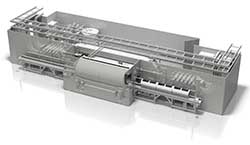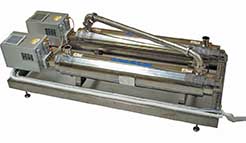Putting on the Pressure
PROCESSING
We have discussed ultraviolet radiation, ionizing radiation, and high pressure processing here over the years, as well as many other topics, but the innovation and new applications continue to flow, driven by increasing interest in sustainability and by consumer preferences for minimally processed products. One good example of the latter influence is the growth in raw and minimally processed fruit and vegetable juices. I confess that the appeal of these thick, green concoctions escapes me, but enough must exist that a major coffee chain invested millions of dollars in a small producer. In particular, some are sold as cleanses—a euphemism for a material that induces a condition we used to consider a hazard of foreign travel.
Many raw juices are treated by high pressure processing (HPP) to extend their shelf life, which otherwise is extremely short, even under refrigeration. Some small manufacturers of raw juices claim that HPP somehow makes a juice less raw, despite the fact that HPP reduces vegetative cells of bacteria with no effect on enzymes or nutrients. Unless one wants to claim that pathogens and spoilage microorganisms are contributors to the benefits of fruit and vegetable juices, I do not see how such claims will prevail in court.
High Pressure Processing
High pressure processing uses pressures of up to 800 Mega Pascals (MPa) to treat foods enclosed in flexible packaging for brief periods of time at temperatures that may be cool, ambient, or elevated to reduce vegetative cells and to deliver some other effects. (The highest pressure level is about 120,000 psi.) The equipment required includes large, thick-walled pressure vessels with appropriate closures and pressure intensifiers capable of raising the pressure in a liquid medium, usually water.
 HPP is inherently a batch process as currently practiced, so one means of increasing capacity is to build larger vessels. Recently, Avure Technologies Inc., Franklin, Tenn. (www.avure.com), displayed a 525 L vessel which, the company says, can achieve 10 cycles per hour, enabling it to process 8,135 lb/hr.
HPP is inherently a batch process as currently practiced, so one means of increasing capacity is to build larger vessels. Recently, Avure Technologies Inc., Franklin, Tenn. (www.avure.com), displayed a 525 L vessel which, the company says, can achieve 10 cycles per hour, enabling it to process 8,135 lb/hr.
Not to be outdone, Hiperbaric (formerly NC Hyperbaric), a Spanish company with its U.S. office in Miami, Fla. (www.hiperbaric.com), offers a similar vessel. Both are horizontal with automated loading and unloading of carriers holding the packaged food.
Packaging for HPP is an interesting challenge. Under these conditions, high water content foods are reduced in volume by about 20%. At the same time, the adiabatic heat of compression can be 3–4°C for each 100 MPa, or 20–30°C at the higher pressures. (Adiabatic just means the temperature change occurs without any heating or cooling from outside the package.) Completely flexible packages, such as pouches or film wrappers, like those around cooked meats, compensate well for the pressure change, but packages like plastic bottles with twist-on caps may experience loss of the seal when the rigid cap responds differently than the more flexible body of the bottle. So far this does not seem to be a major problem, but it illustrates a non-obvious area of concern with a new technology.
HPP units are relatively expensive, so many of the smaller manufacturers of juices are having products processed at co-manufacturers, including Hiperbaric, which operates a demonstration unit and accepts some toll processing.
Other applications, beyond juices, include ready-to-eat meats, for which Listeria monocytogenes is a particular hazard, and seafood, where HPP provides pasteurization and shucking of shellfish and also enables high yield removal of meat from crustaceans, such as lobsters.
HPP does not kill bacterial spores, the hardy forms of certain microorganisms. In particular, Clostridium botulinum is the spore-forming, toxin-producing microbe of concern in low acid foods (pH above 4.6). A combination process, in which foods are heated to at least 121°C while subjected to HPP, has been approved by the U.S. Food and Drug Administration (FDA). Known as pressure assisted thermal sterilization (PATS), the process subjects foods to a milder thermal treatment than does conventional canning. One advantage is that when the pressure is released, the food very quickly cools. I am not aware whether the process is commercially practiced. Most HPP applications appear to yield refrigerated products with extended but still modest shelf lives.
--- PAGE BREAK ---
Ultraviolet Radiation
Ultraviolet (UV) radiation is widely practiced for sterilization of water, air, and some surfaces, but is only recently finding direct food applications. One reason is the low penetration depth of UV in turbid or colored fluids, such as most juices and milk. However, when applied in properly designed devices, UV can be effective for such materials.
Tatiana Koutchma ([email protected]), Research Scientist in Novel Food Processing, Agriculture and Agri-Food Canada, Guelph, Ontario, has evaluated several UV reactors or applicators. The general principle is to create a thin layer of the fluid and expose it to UV radiation produced by low-pressure mercury lamps. These lamps produce radiation at 254 nanometers (nm).
If fluids are in laminar flow, as occurs for relatively viscous fluids at low flow rates, there is a distribution of velocities such that the fastest-moving portion of fluid moves at twice the average velocity. This leads to a distribution in exposure time for the target microorganisms. Consequently, according to Koutchma, the FDA stipulates that UV light reactors maintain turbulent flow, in which the fastest portion of flowing fluid is only 1.2 times the average velocity, giving a more uniform treatment.
This requirement can lead to challenges with viscous fluids, because it requires more energy to generate the required velocities. The same issue of residence time distribution arises in designing hold tubes for continuous pasteurizers and sterilizers. In those cases, the hold tube is designed so that the fastest-moving portions of the fluid receive an adequate treatment; it might be possible to use the same approach in designing UV reactors. The FDA stipulates a Reynolds number of 2200, which is not really turbulent by most standards.
The implementations described by Koutchma include flow through an annular space between an array of lamps and a shell (CiderSure, FPE Inc., Macedon, N.Y.); flow in the annular space between a moving rotor and an array of lamps (described by Forney and Pierson, 2004); flow around an array of arc-tubes, each in a quartz sleeve within a stainless steel chamber (Aquionics UV reactor, Hanovia Ltd., Slough, England, www.hanovia.com); and flow through a coiled Teflon tube surrounded by 24 lamps and reflectors (Salcor Inc., Fallbrook, Calif.).
 MicroTek Processes Ltd., Gloucestershire, England (www.microtekprocesses.com), offers a unique UV lamp powered by microwave energy instead of direct connection to electricity. One consequence is higher efficiency in converting electricity to UV radiation. The lamp is low pressure and generates lower temperatures at the lamp surface than do other lamps, so can have less fouling. According to Allan Slater, Managing Director, MicroTek has demonstrated its process on milk in comparison with a different process in which milk is first separated, then the skim is microfiltered while the cream is thermally pasteurized and the two streams are combined and homogenized. In the MicroTek process, the milk is exposed to UV in a proprietary reactor. They claim improved flavor, extended shelf life, and lower cost than competing processes.
MicroTek Processes Ltd., Gloucestershire, England (www.microtekprocesses.com), offers a unique UV lamp powered by microwave energy instead of direct connection to electricity. One consequence is higher efficiency in converting electricity to UV radiation. The lamp is low pressure and generates lower temperatures at the lamp surface than do other lamps, so can have less fouling. According to Allan Slater, Managing Director, MicroTek has demonstrated its process on milk in comparison with a different process in which milk is first separated, then the skim is microfiltered while the cream is thermally pasteurized and the two streams are combined and homogenized. In the MicroTek process, the milk is exposed to UV in a proprietary reactor. They claim improved flavor, extended shelf life, and lower cost than competing processes.
MicroTek and others also offer configurations for exposing surfaces to UV. A good application is to sterilize packaging containers and film as an alternative to hot fill. The concept of hot fill is to use hot liquid, after it has been heated sufficiently to kill pathogens, to sterilize the container. Obviously, the container has to withstand the heat without distortion or weakening of seals, which means that plastic containers are heavier than they would otherwise need to be. Glass or metal containers are not usually an issue, though care must be taken with glass containers during cooling not to induce thermal shock and breakage.
If plastic containers can be made lighter, there is a cost savings, so cooler filling would be advantageous. Sterilizing the containers and closure with UV is a possible answer. It is wise to fill above 140°F so that the product does not become recontaminated.
In applying UV to surfaces, the issue of shadowing arises. Flat surfaces, such as film, are relatively easy, but other shapes need care in design and validation that all surfaces are properly treated.
Pulsing UV is a variation that offers some advantages because of the very high intensity that can be applied by storing and releasing electric energy in capacitors.
High pressure processing and UV are two of the more promising and innovative preservation processes slowly being adopted in the food industry. Research continues on understanding better the mechanisms by which they work and applying the technologies to new situations. One might wonder if some combination of the two has some advantage.
 J. Peter Clark, Ph.D., CFS,
J. Peter Clark, Ph.D., CFS,
Contributing Editor, Consultant to the Process Industries, Oak Park, Ill.
[email protected]
